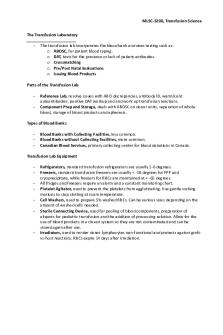Intro to Oceanography 9 PDF

| Title | Intro to Oceanography 9 |
|---|---|
| Course | Introduction to Oceanography |
| Institution | University of California Santa Barbara |
| Pages | 1 |
| File Size | 69 KB |
| File Type | |
| Total Downloads | 46 |
| Total Views | 132 |
Summary
Professor Valentine described the ocean in regards to wind patterns, currents, and marine life....
Description
● ● ● ●
Valentine’s fave explorer: James Cook S. America drifted into Pacific Ocean basin Subduction: forms trenches (oceanic lithosphere) Fracture zones: extend from faults to ocean crust
10/19- First Lecture After Midterm #1 ● Ocean structure: distribution of temp. and salts in ocean ● Water occurs on Earth as solid, liquid & gas Liquid: free upper surface, flows freely to lower level, molecules close together & glide easily past each other Gas: fill closed space uniformly, molecules colliding with one another, readily compressed into smaller volume, low density, molecules in high speed motion Solid (ice): strong & rigid, molecules can fissure & break, high density, fractures when sudden, strong stress applied, molecules locked into strict geometrical order ● Salinity: measure of salt content ● Water is a polar chemical compound (H20)- solvent which dissolves things ● Heat (measure of energy) & temperature (measure of response of a substance to the removal or addition of energy)- not same thing! ● Thermal properties keep mild conditions on earth ● Water density greatly affected by temp. and salinity ●
Chemical & physical water properties make it ideal to support life → follow water for life (THG when Katniss found wet moss bc animals need water to survive)
● ● ●
Compounds: substances that contain 2+ diff elements in fixed proportions Element: substance can’t be broken down further (hydrogen, oxygen) Atoms: particles that make up elements
●
Water is polar: a positive & negative side 2 positive H atoms share electrons with one negative O atom → covalent bond (H2O)
● ● ● ● ● ●
Covalent bond: long term hook ups Tetrahedron: 109.5 degrees (angle) H bonds forms when positive end of one water molecule bonds to negative end of another water molecule- hydrogen bond (not covalent) Heat: energy produced by random vibrations of atoms or molecules (cal) Temperature: object’s response to input or removal of heat (°C) Heat capacity: measure of the heat required to raise temperature of 1g of a substance by 1°C- proportion Water has very high heat capacity (1 cal)→ resists changing temp when heat is added or removed
● ●
1000 calories = 1 kilocalorie= 1 Cal Common states of matter: liquid, gas, solid...
Similar Free PDFs

Intro to Oceanography 9
- 1 Pages

Chemical Oceanography
- 594 Pages

Intro to textiles
- 8 Pages

Intro to Med Term
- 41 Pages

Intro to Tinker CAD
- 3 Pages

Intro to Oscilloscopes
- 8 Pages

Intro to Sociology
- 34 Pages

Intro to Transfusion Science
- 3 Pages

Intro to computational physics
- 3 Pages

Intro to marketing syllabus
- 19 Pages

Intro to Corp Finance
- 55 Pages

Intro to Python Worksheet
- 9 Pages
Popular Institutions
- Tinajero National High School - Annex
- Politeknik Caltex Riau
- Yokohama City University
- SGT University
- University of Al-Qadisiyah
- Divine Word College of Vigan
- Techniek College Rotterdam
- Universidade de Santiago
- Universiti Teknologi MARA Cawangan Johor Kampus Pasir Gudang
- Poltekkes Kemenkes Yogyakarta
- Baguio City National High School
- Colegio san marcos
- preparatoria uno
- Centro de Bachillerato Tecnológico Industrial y de Servicios No. 107
- Dalian Maritime University
- Quang Trung Secondary School
- Colegio Tecnológico en Informática
- Corporación Regional de Educación Superior
- Grupo CEDVA
- Dar Al Uloom University
- Centro de Estudios Preuniversitarios de la Universidad Nacional de Ingeniería
- 上智大学
- Aakash International School, Nuna Majara
- San Felipe Neri Catholic School
- Kang Chiao International School - New Taipei City
- Misamis Occidental National High School
- Institución Educativa Escuela Normal Juan Ladrilleros
- Kolehiyo ng Pantukan
- Batanes State College
- Instituto Continental
- Sekolah Menengah Kejuruan Kesehatan Kaltara (Tarakan)
- Colegio de La Inmaculada Concepcion - Cebu



